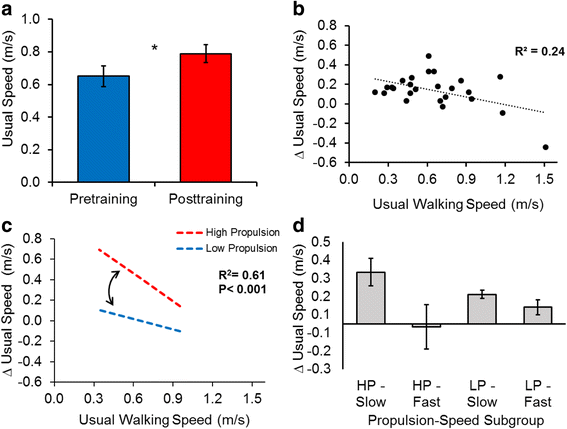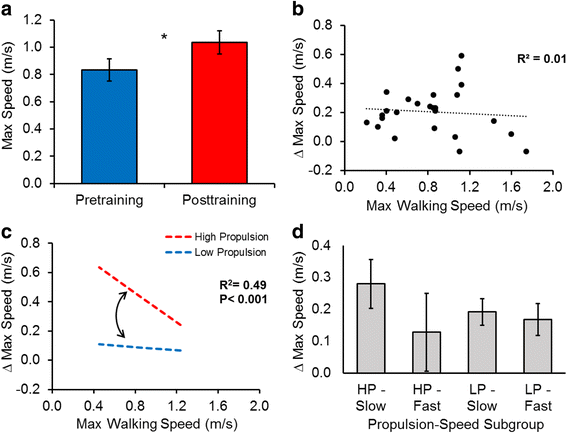Identifying candidates for targeted gait rehabilitation after stroke: better prediction through biomechanics-informed characterization
- PMID: 27663199
- PMCID: PMC5035477
- DOI: 10.1186/s12984-016-0188-8
Identifying candidates for targeted gait rehabilitation after stroke: better prediction through biomechanics-informed characterization
Abstract
Background: Walking speed has been used to predict the efficacy of gait training; however, poststroke motor impairments are heterogeneous and different biomechanical strategies may underlie the same walking speed. Identifying which individuals will respond best to a particular gait rehabilitation program using walking speed alone may thus be limited. The objective of this study was to determine if, beyond walking speed, participants' baseline ability to generate propulsive force from their paretic limbs (paretic propulsion) influences the improvements in walking speed resulting from a paretic propulsion-targeting gait intervention.
Methods: Twenty seven participants >6 months poststroke underwent a 12-week locomotor training program designed to target deficits in paretic propulsion through the combination of fast walking with functional electrical stimulation to the paretic ankle musculature (FastFES). The relationship between participants' baseline usual walking speed (UWSbaseline), maximum walking speed (MWSbaseline), and paretic propulsion (propbaseline) versus improvements in usual walking speed (∆UWS) and maximum walking speed (∆MWS) were evaluated in moderated regression models.
Results: UWSbaseline and MWSbaseline were, respectively, poor predictors of ΔUWS (R 2 = 0.24) and ΔMWS (R 2 = 0.01). Paretic propulsion × walking speed interactions (UWSbaseline × propbaseline and MWSbaseline × propbaseline) were observed in each regression model (R 2 s = 0.61 and 0.49 for ∆UWS and ∆MWS, respectively), revealing that slower individuals with higher utilization of the paretic limb for forward propulsion responded best to FastFES training and were the most likely to achieve clinically important differences.
Conclusions: Characterizing participants based on both their walking speed and ability to generate paretic propulsion is a markedly better approach to predicting walking recovery following targeted gait rehabilitation than using walking speed alone.
Keywords: Biomechanics; Efficacy; Electrical stimulation; FES; Gait; Locomotion; Physical Therapy; Prediction; Prognostic; Rehabilitation; Stroke; Walking.
Figures


Similar articles
-
Gait Rehabilitation Using Functional Electrical Stimulation Induces Changes in Ankle Muscle Coordination in Stroke Survivors: A Preliminary Study.Front Neurol. 2018 Dec 20;9:1127. doi: 10.3389/fneur.2018.01127. eCollection 2018. Front Neurol. 2018. PMID: 30619077 Free PMC article.
-
Paretic propulsion as a measure of walking performance and functional motor recovery post-stroke: A review.Gait Posture. 2019 Feb;68:6-14. doi: 10.1016/j.gaitpost.2018.10.027. Epub 2018 Oct 25. Gait Posture. 2019. PMID: 30408710 Free PMC article. Review.
-
Reducing The Cost of Transport and Increasing Walking Distance After Stroke: A Randomized Controlled Trial on Fast Locomotor Training Combined With Functional Electrical Stimulation.Neurorehabil Neural Repair. 2016 Aug;30(7):661-70. doi: 10.1177/1545968315619696. Epub 2015 Nov 30. Neurorehabil Neural Repair. 2016. PMID: 26621366 Free PMC article. Clinical Trial.
-
Task-specific training for improving propulsion symmetry and gait speed in people in the chronic phase after stroke: a proof-of-concept study.J Neuroeng Rehabil. 2021 Apr 23;18(1):69. doi: 10.1186/s12984-021-00858-8. J Neuroeng Rehabil. 2021. PMID: 33892754 Free PMC article. Clinical Trial.
-
Effectiveness of rehabilitation interventions to improve paretic propulsion in individuals with stroke - A systematic review.Clin Biomech (Bristol). 2020 Jan;71:176-188. doi: 10.1016/j.clinbiomech.2019.10.021. Epub 2019 Oct 21. Clin Biomech (Bristol). 2020. PMID: 31770660
Cited by
-
The Effects of Stroke and Stroke Gait Rehabilitation on Behavioral and Neurophysiological Outcomes:: Challenges and Opportunities for Future Research.Dela J Public Health. 2023 Aug 31;9(3):76-81. doi: 10.32481/djph.2023.08.013. eCollection 2023 Aug. Dela J Public Health. 2023. PMID: 37701480 Free PMC article.
-
Targeting Paretic Propulsion and Walking Speed With a Soft Robotic Exosuit: A Consideration-of-Concept Trial.Front Neurorobot. 2021 Jul 28;15:689577. doi: 10.3389/fnbot.2021.689577. eCollection 2021. Front Neurorobot. 2021. PMID: 34393750 Free PMC article.
-
Gait Rehabilitation Using Functional Electrical Stimulation Induces Changes in Ankle Muscle Coordination in Stroke Survivors: A Preliminary Study.Front Neurol. 2018 Dec 20;9:1127. doi: 10.3389/fneur.2018.01127. eCollection 2018. Front Neurol. 2018. PMID: 30619077 Free PMC article.
-
Paretic propulsion as a measure of walking performance and functional motor recovery post-stroke: A review.Gait Posture. 2019 Feb;68:6-14. doi: 10.1016/j.gaitpost.2018.10.027. Epub 2018 Oct 25. Gait Posture. 2019. PMID: 30408710 Free PMC article. Review.
-
Mechanics and energetics of post-stroke walking aided by a powered ankle exoskeleton with speed-adaptive myoelectric control.J Neuroeng Rehabil. 2019 May 15;16(1):57. doi: 10.1186/s12984-019-0523-y. J Neuroeng Rehabil. 2019. PMID: 31092269 Free PMC article.
References
-
- Lloyd-Jones D, Adams RJ, Brown TM, Carnethon M, Dai S, De Simone G, Ferguson TB, Ford E, Furie K, Gillespie C, Go A, Greenlund K, Haase N, Hailpern S, Ho PM, et al. Heart disease and stroke statistics--2010 update: a report from the American Heart Association. Circulation. 2010;121(7):e46–e215. doi: 10.1161/CIRCULATIONAHA.109.192667. - DOI - PubMed
Grants and funding
LinkOut - more resources
Full Text Sources
Other Literature Sources
Medical
Miscellaneous

